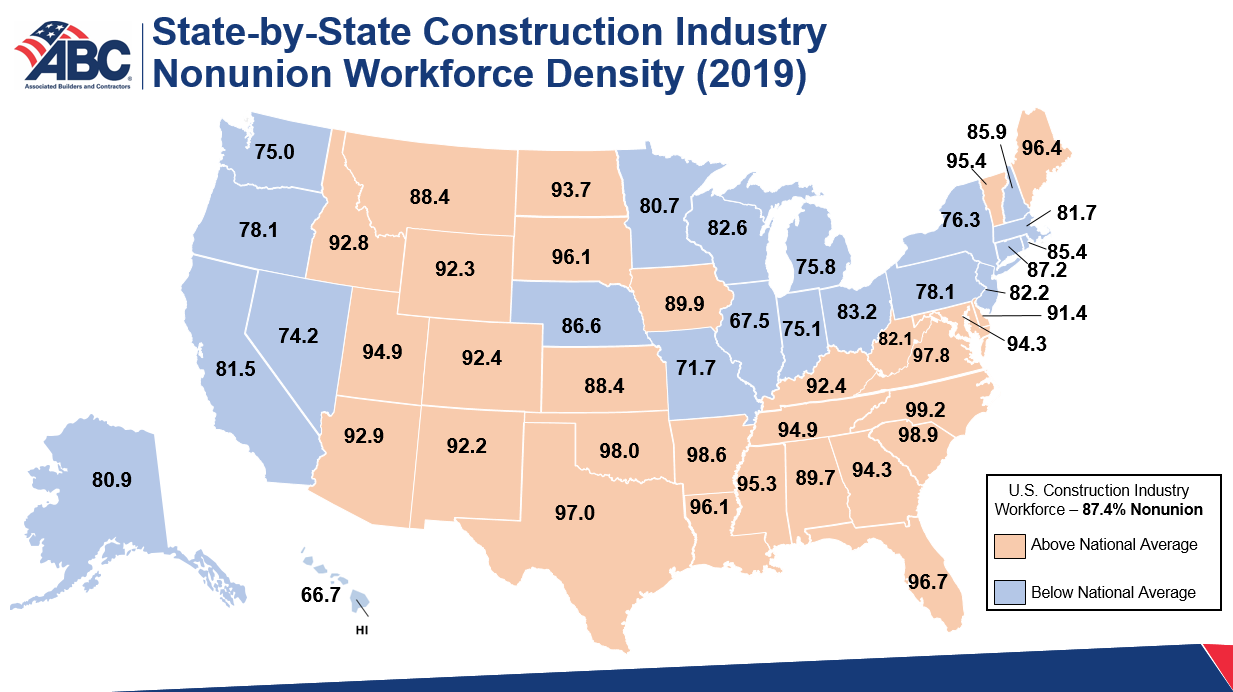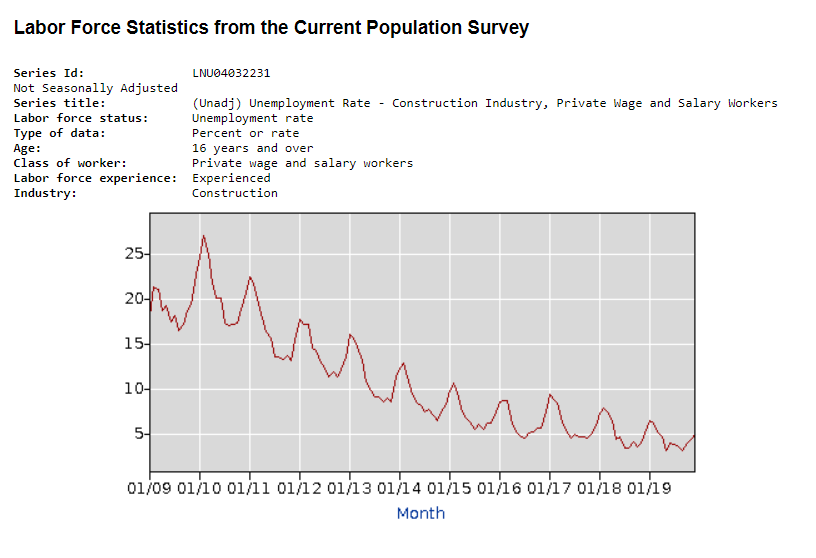BLS: Just 12.6% of U.S. Construction Industry is Unionized
According to data from the Bureau of Labor Statistics’ annual union members summary report published Jan. 22, 2020, union membership in the construction industry increased slightly in 2019.
However, just 12.6% of wage and salary workers were members of unions in the U.S. private construction industry, a decrease from 12.8% in 2018.
According to BLS data, construction unions gained just 7,000 members in a year-over-year comparison (1.048 million workers in 2018 to 1.055 million workers in 2019), even though the U.S. construction industry added 192,000 workers, (8.169 million workers in 2018 to 8.352 million workers in 2019).
This data suggests that fewer workers chose to join unions as the construction industry’s workforce grew in the robust U.S. economy. Likewise, union membership as a percentage of the U.S. construction industry has steadily declined throughout the last 75 years. In 1947, approximately 87% of its workforce was unionized. During the nadir of the construction industry’s recession in 2010, just 801,000 construction industry workers belonged to a union (13.1% ), the smallest number of union members in recent history.
Visit the BLS’ website to view the news release and the full report
Updated state-specific union membership information for various U.S. industries, including the construction industry, is available at Table II of unionstats.com and below (.ppt).


Construction Industry Job Growth in 2019
The nonresidential merit shop construction sector continues to perform extremely well more than 10 years into the U.S. economy’s longest expansion. Construction backlog hit 8.48 months in December 2019, according to ABC’s Construction Backlog Indicator. And the latest ABC Construction Confidence Index increased with respect to sales, profit margins and staffing.
The most recent BLS data puts the construction industry unemployment rate at 5% for December 2019, which is a decline from the 5.1% unemployment rate in a year-over-year comparison. In contrast, the construction industry unemployment rate was 27.1% in February 2010. Construction employment expanded by 44,000 net new jobs in January and across the industry.

In December 2019, estimated not seasonally adjusted construction unemployment rates fell nationally and in 24 states, rose in 25 states and were unchanged in one state (New York) on a year-over-year basis, according to an analysis of BLS data.
National nonresidential construction spending increased by 1.6% in January 2020 and is up 5.1% on a year-over-year basis, according to an Associated Builders and Contractors analysis of data published March 2 by the U.S. Census Bureau. On a seasonally adjusted annualized basis, spending totaled a record $806.9 billion in January.
The strength and health of the construction industry’s unions can impact the public policy debate surrounding anti-competitive and costly government-mandated project labor agreements.
PLAs typically ensure construction contracts are awarded only to companies that agree to recognize unions as the representatives of their employees on that job; use the union hiring hall to obtain workers at the expense of most or all of its existing qualified employees; obtain apprentices exclusively through union apprenticeship programs; follow inefficient union work rules; pay into union benefit and multi-employer pension plans workers will never benefit from unless they meet vesting requirements; and force workers to pay union dues and/or join a union as a condition of employment.
Discouraging competition from qualified merit shop contractors and their skilled nonunion construction workforce via PLA mandates costs taxpayers a fortune. When mandated by a government agency on taxpayer-funded projects, PLAs drive up the cost of construction projects anywhere from 12% to 20%, on average, according to a series of academic studies.
A study released in January 2020 by the Beacon Hill Institute found that Connecticut schools built under controversial government-mandated PLAs cost 19.8% more than schools that were bid and constructed through fair and open competition, free from PLA requirements. Similar Beacon Hill Institute studies on the impact of PLA mandates on school construction in New Jersey (2019) and Ohio (2017) found schools built with government-mandated PLAs were more expensive compared to school projects not built with PLAs.
In 2020, ABC will continue to fight for federal, state and local policies that create a level playing field in the procurement of government construction contracts, increase competition, help small businesses grow, curb construction costs and create jobs and opportunities for all Americans and all qualified construction industry businesses.
Advocating for inclusive policies so all Americans and all qualified companies can rebuild America’s infrastructure is a win-win for taxpayers and the U.S. economy.











